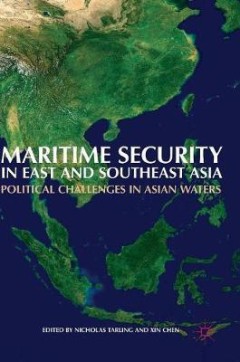Ditapis dengan
A History of Early Southeast Asia: Maritime Trade and Societal Development, 1…
This comprehensive history provides a fresh interpretation of Southeast Asia from 100 to 1500, when major social and economic developments foundational to modern societies took place on the mainland (Burma, Thailand, Cambodia, and Vietnam) and the island world (Indonesia, Malaysia, and the Philippines). Incorporating the latest archeological evidence and international scholarship, Kenneth R. Ha…
- Edisi
- -
- ISBN/ISSN
- 978-0-7425-6762-7
- Deskripsi Fisik
- ix, 384 p
- Judul Seri
- -
- No. Panggil
- TXT MR HAL a

Southeast asia : an introductory history
While deepening our understanding of Southeast Asia, this fine introduction reminds us of the importance of history itself. ' - Anthony Milner, Basham Professor of Asian History, Australian National University 'Still one of the best short introductory histories to the region even after nine editions.' - Eric Tagliacozzo, Cornell University The first edition of Southeast Asia; An introductory hi…
- Edisi
- -
- ISBN/ISSN
- 978-1-74331-267-4
- Deskripsi Fisik
- xiv, 351 p, 21 cm ; index
- Judul Seri
- -
- No. Panggil
- LC 959 OSB s

Competition for transhipment containers by major ports in Southeast Asia: slo…
Container ports in Southeast Asia accounted for an estimated 30.0% of the world’s transhipment traffic in 2004. The share of the region’s transhipment trade was forecasted to increase to 32.5% in 2015. The potential offered by this large and expanding market encouraged major container terminal operators located in Port Klang, Singapore and Tanjung Pelepas to compete intensively for this bus…
- Edisi
- VOL. 35, NO. 1, 89–101
- ISBN/ISSN
- 1464–5254
- Deskripsi Fisik
- 15 p.
- Judul Seri
- Maritime Policy & Management: The flagship journal of international shipping and port research
- No. Panggil
- ATC LO LAM c

Maritime security in east and southeast asia : political challenges in asian …
- Edisi
- -
- ISBN/ISSN
- 978-981-10-2588-4
- Deskripsi Fisik
- xiii, 254 p.
- Judul Seri
- -
- No. Panggil
- TXT MR TAR m
- Edisi
- -
- ISBN/ISSN
- 978-981-10-2588-4
- Deskripsi Fisik
- xiii, 254 p.
- Judul Seri
- -
- No. Panggil
- TXT MR TAR m

A Delphi Study on the Potential Benefits and Obstacles of Interstate Short Se…
The aim of this paper is to identify the potential benefits and obstacles of the interstate Short Sea Shipping (SSS) operation in the archipelagic Southeast Asia sub-region. Although literature has addressed a myriad of benefits and obstacles that were caused by the SSS operation as an alternative mode to unimodal land transport, it has been recognised that each SSS corridor may have its own pe…
- Edisi
- -
- ISBN/ISSN
- -
- Deskripsi Fisik
- 14 p .
- Judul Seri
- Original article
- No. Panggil
- ATC LO ARO a

A competitive strategic position analysis of major container ports in southea…
The importance of planning strategies to achieve higher competitiveness has become more apparent in the context of seaports since seaports have been encountering quickly changing and highly competitive business environments. Therefore, the strategic competitive position of seaports needs to be investigated using strategic positioning methods. The purpose of this study was to analyze the competi…
- Edisi
- -
- ISBN/ISSN
- -
- Deskripsi Fisik
- 7 p.
- Judul Seri
- The Asian Journal of Shipping and Logistic
- No. Panggil
- ATC LO LIN a

The rise of Chinese ports and its impact on major ports in East Asia
The economic rise of China and its implications for the rest of the world are well discussed in the literature. However, the literature on the rise of Chinese ports and how they could impact the ports in East Asia is very limited. Moreover, although there are few studies on the effect of Chinese port growth on the ports in East Asia, these are theoretical, descriptive or do not cover all major …
- Edisi
- Vol. 18, 1, 19–40
- ISBN/ISSN
- -
- Deskripsi Fisik
- 22 p.
- Judul Seri
- -
- No. Panggil
- ATC PO TON t

Maritime security and threats to energy transportation in Southeast Asia
Southeast Asia contains some of the world’s busiest and most strategic chokepoints for maritime commerce, making it a sub-region of global strategic interest. Yet the vital energy shipments through the region are subject to potential disruption caused by maritime safety challenges, legal-passage regimes, piracy and terrorism, and inter-state conflict. In addition, potential counter-trends cou…
- Edisi
- VOL. 160 NO.2pp. 20–31
- ISBN/ISSN
- -
- Deskripsi Fisik
- 13 p.
- Judul Seri
- -
- No. Panggil
- ATC MR GRA m

Port choice model of transhipment cargo using system dynamics
The aim of this chapter is to identify factors that have been affecting the increase of transhipment (T/S) cargoes of the port of Busan and to explore how these factors can be utilised more effectively to attract and increase T/S cargoes through the development of a port choice model using the technique of system dynamics (SD). To clarify the reason why T/S cargoes have increased in the port of…
- Edisi
- -
- ISBN/ISSN
- -
- Deskripsi Fisik
- 25 p.
- Judul Seri
- Maritime Logistics
- No. Panggil
- ATC LO KYU p
 Karya Umum
Karya Umum  Filsafat
Filsafat  Agama
Agama  Ilmu-ilmu Sosial
Ilmu-ilmu Sosial  Bahasa
Bahasa  Ilmu-ilmu Murni
Ilmu-ilmu Murni  Ilmu-ilmu Terapan
Ilmu-ilmu Terapan  Kesenian, Hiburan, dan Olahraga
Kesenian, Hiburan, dan Olahraga  Kesusastraan
Kesusastraan  Geografi dan Sejarah
Geografi dan Sejarah